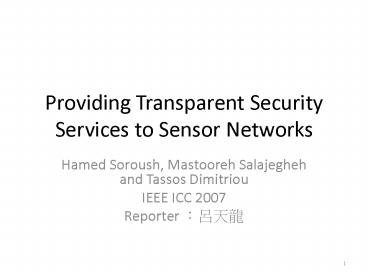Providing Transparent Security Services to Sensor Networks - PowerPoint PPT Presentation
Title:
Providing Transparent Security Services to Sensor Networks
Description:
Message Modification and Impersonation Attacks: message Authentication Codes ... Authentication, Access Control and Integrity (A): the Counter field is not ... – PowerPoint PPT presentation
Number of Views:32
Avg rating:3.0/5.0
Title: Providing Transparent Security Services to Sensor Networks
1
Providing Transparent Security Services to Sensor
Networks
- Hamed Soroush, Mastooreh Salajegheh and Tassos
Dimitriou - IEEE ICC 2007
- Reporter ???
2
Outline
- Introduction
- Problem Formulation
- Related Work
- Key Management Module
- Proposed Security Platform
- Conclusion
- References
3
Introduction(1/1)
- Sensor networks are usually deployed in hostile
environments, many of their applications require
that data must be exchanged in a secure and
authenticated manner. - Public key cryptography is also considered to be
computationally expensive for WSN. - Any WSN security protocol has to be flexible and
scalable enough to easily allow nodes to join or
leave the network.
4
Problem Formulation(1/2)
- A few reasonable assumptions
- Sensor nodes in the network are not mobile.
- The base station is safe and adversaries cannot
compromise it.
5
Problem Formulation(2/2)
- Requirements for a practical WSN security
platform - Flexibility
- Scalability
- Transparency
- Lightweightness
- Node Capture Resistance
- Simplicity
6
Related Work(1/3)
7
Related Work(2/3)
- three major approaches for key management in WSN
- Deterministic pre-assignment
- Random pre-distribution
- Deterministic post-deployment derivation
8
Related Work(3/3)
9
Key Management Module(1/4)
- Key establishment module establishes the
following kinds of keys - Pair-wise (PW) key
- Broadcast (BC) key
- Node-Base (NB) key
- Kglobal master key Fhash function
10
Key Management Module(2/4)
11
Key Management Module(3/4)
- The memory overhead of our key management module
for each node can be calculated as follows - BC,PW and NBsize of broadcast key,
pair-wise key and node-base key. - dthe maximum number of neighbors each node may
have.
12
Key Management Module(4/4)
13
Proposed Security Platform(1/6)
- This platform provides security against several
types of attacks as follows - Replay Attacks use the increasing counter value
to guarantee the freshness of the messages. - Node Capture Attacks
- Denial of Service Attacks detect unauthorized
packets before delivering them to application
layer for further processing and stop them from
spreading into the network.
14
Proposed Security Platform(2/6)
- Message Modification and Impersonation Attacks
message Authentication Codes (MAC) can be used to
let the receiver nodes detect any modifications
of received messages from the original one. - Attacks on Confidentiality appropriate
encryption mechanisms
15
Proposed Security Platform(3/6)
16
Proposed Security Platform(4/6)
17
Proposed Security Platform(5/6)
- Authentication, Access Control and Integrity (A)
the Counter field is not required, but obviously
the MAC field is needed. - Confidentiality (C) source and Counter fields
are used in the packet format , however receiver
nodes do not save the related counter values.
18
Proposed Security Platform(6/6)
- Replay Attack Protection (R) Source and Counter
fields are also necessary, but the counter value
of each neighbor is kept.
19
Conclusion(1/2)
- post-distribution key management module allowing
for the provision of several security services
such as acceptable resistance against node
capture attacks and replay attacks. - lightweight and allows for high scalability while
being easy to use and transparent to the users.
20
Conclusion(2/2)
- This platform is flexible enough to allow
different types of security services for
different types of communications among nodes.
21
References(1/2)
- 1 C. Karlof, N.Sastry, D. Wagner, TinySec
Link Layer Encryption for Tiny Devices, ACM
SenSys, 2004 - 2 A. Perrig, R. Szewczyk, V. Wen, D. culler, D.
Tygar, SPINS Security Protocols for Sensor
Networks, ACM CCS, 2003 - 3 Q. Xue, A. Ganz, Runtime Security
Composition for Sensor Networks (SecureSense),
IEEE Vehicular Technology Conference, 2003 - 4 S. J. S. Zhu, S. Setia, LEAP Efficient
security mechanism for large-scale distributed
sensor networks, ACM CCS, 2003 - 5 T. Li, H. Wu, F. Bao, SenSec Design,
Institue for InfoComm Research, Tech. Rep.
TR-I2R-v1.1, 2005 - 6 H. Chan, A. Perrig, PIKE Peer
Intermediaries for Key Establishment in Sensor
Networks, Proceedings of IEEE Infocom, 2005 - 7 S.Capkun, J.P. Hubaux, Secure positioning of
wireless devices with application to sensor
networks, IEEE Infocom, 2005
22
References(2/2)
- 8 S. Ganeriwal, S. Capkun, C. C. Han, M. B.
Srivastava, Secure time synchronization service
for sensor networks, ACM WiSe, 2005 - 9 L. Eschenauer and V. D. Gligor, A
key-management scheme for distributed sensor
networks, ACM CCS, 2002 - 10 H. Chan, A. Perrig, D. Song, Random Key
Predistribution Schemes for Sensor Networks,
IEEE Symposium on Security and Privacy, 2003 - 11 D. Liu, P. Ning, Establishing pairwise keys
in distributed sensor networks, ACM CCS, 2003 - 12 J. Hill, et al, System architecture
directions for networked sensors, in Proceedings
of ACM ASPLOS IX, 2000 - 13 Anderson, R., Kuhn, M. Tamper resistance -
a cautionary note. In Proc. of the Second Usenix
Workshop on Electronic Commerce, (1996) 111































